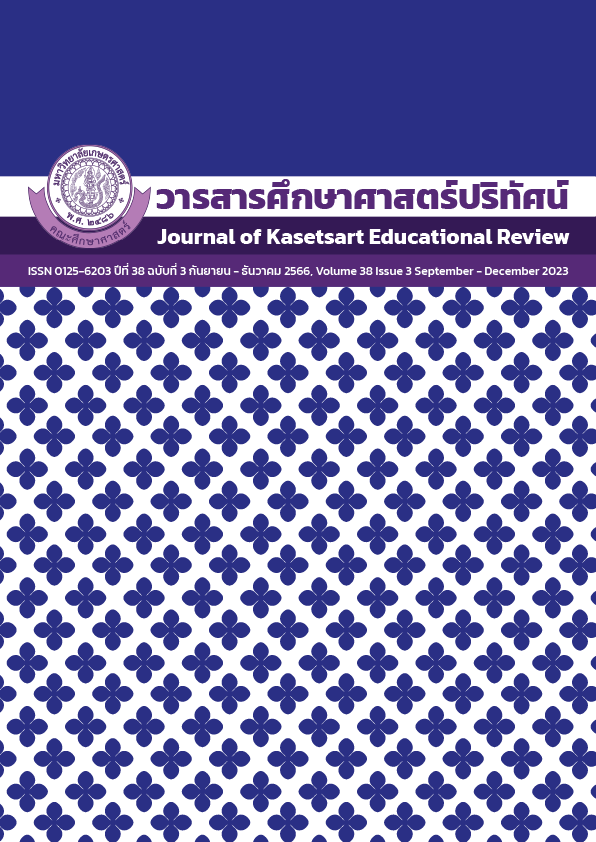Development of Reciprocal Teaching Model to Enhance Pedagogy Reading Comprehension for Undergraduate Students
คำสำคัญ:
รูปแบบการสอนที่เอื้อซึ่งกันและกัน, การสอนเพื่อความเข้าใจในการอ่าน, นักศึกษาระดับปริญญาตรีบทคัดย่อ
การวิจัยครั้งนี้ มีวัตถุประสงค์เพื่อประเมินปัจจัยที่ส่งผลกระทบต่อการสอนเพื่อความเข้าใจในการอ่านสำหรับนักศึกษาปริญญาตรี ข้อมูลการวิจัยเก็บจากประชากรจำนวน 150 คน และกลุ่มตัวอย่างผู้สอน 3 คน จาก Hechi University ได้แก่ Literature and Media College, Music and Dance College, and Teacher Education College เครื่องมือในการวิจัยครั้งนี้ใช้แบบสอบถามสำหรับนักศึกษาและแบบสัมภาษณ์สำหรับผู้เชี่ยวชาญ สำหรับการวิเคราะห์ข้อมูลเชิงปริมาณใช้ค่าร้อยละ ค่าเฉลี่ย และส่วนเบี่ยงเบนมาตรฐาน ส่วนข้อมูลเชิงคุณภาพใช้การวิเคราะห์เนื้อหา
ผลการวิจัยพบว่า ปัจจัยภายในและภายนอกที่ส่งผลต่อความสามารถในการอ่านสำหรับนักศึกษาปริญญาตรีจากกลุ่มของนักศึกษาอยู่ในระดับสูง ปัจจัยภายในระดับที่สูงจากการตอบแบบสอบถามของนักศึกษา ได้แก่ แรงจูงใจภายในของนักศึกษา การรับรู้ความสำคัญของรายวิชา ตระหนักถึงประโยชน์ของการอ่านต่ออาชีพ ปัจจัยภายนอกระดับที่สูงจากการตอบแบบสอบถามของนักศึกษา ได้แก่ การให้ข้อมูลป้อนกลับ การใช้วิธีการสอนที่หลากหลาย สิ่งแวดล้อมในการสอน สำหรับการสัมภาษณ์อาจารย์ พบว่า ปัจจัยภายในที่อาจารย์ระบุ ได้แก่ ผู้สอนและวิธีการสอน ส่วนปัจจัยภายนอกที่อาจารย์ระบุ ได้แก่ สื่ออุปกรณ์ การประเมินผล สภาพแวดล้อมและขนาดชั้นเรียน
เอกสารอ้างอิง
Ardiansyah, W. & Ujihanti, M. (2018). Social constructivist learning theory and reciprocal teaching to teach reading comprehension. International Journal of Learning and Teaching, 10(1), 70-77.
Ahmadi, M.R. & Hairul,N.I. (2012). Reciprocal teaching as an important factor of improvingreading comprehension. Journal of Studies in Education, 2(4), 153-173.
Barrett, P., Zhang, Y., Moffat, J., & Kobbacy, K. (2013). A holistic, multi-level analysis identifying the impact of classroom design on pupils’ learning. Building and Environment, 59, 678-689.
Calderón, M., Slavin, R., & Sanchez, M. (2011). Effective instruction for English learners. The future of children, 103-127.Available from:https://www.specialsci.cn/detail/3aeb1799-4a56-4179-b045-3ea61706e62a
Rosenshine, B., & Meister, C. (1992). The use of scaffolds for teaching higher-level cognitive strategies. Educational Leadership, 49(7), 26-33.
Carver, C. S., & Scheier, M. F. (2001). On the self-regulation of behavior. Cambridge University Press.
Dierking, L. D., & Falk, J. H. (2010). The 95 percent solution: school is not where most Americans learn most of their science. The American Scientist, 98(6),486-494.
Doolittle, P. E., Hicks, D., Triplett, C. F., Nichols, W. D., & Young, C. A. (2006). Reciprocal teaching for reading comprehension in higher education: A strategy for fostering the deeper understanding of texts. International Journal of Teaching and Learning in Higher Education, 17(2), 106-118.
Eysenck, H. J. (1967). The biological basis of personality. Charles C Thomas Publisher.
Fielding, L. G., & Pearson, P. D. (1994). Reading Comprehension: What Works. Educational leadership, 51(5), 62-68.
Grabe, W. (2014). Reading in a second language: Moving from theory to practice (2nded.). Cambridge: Cambridge University Press. (Online). Available from https://www.specialsci.cn/detail/037ee67c-ef94-4f61-b58a-c4b22d9f3e32
Gottfredson, L. S. (1997). Why g matters: The complexity of everyday life. Intelligence, 24(1), 79-132.
Hechi University.( 2022). Curriculum of Pedagogy Course. Department of Education. Hechi University.
Hart, E. R., & Speece, D. L. (1998). Reciprocal teaching goes to college: Effects for postsecondary students
at risk for academic failure. Journal of Educational Psychology, 90(4), 670. Available from:https://www.specialsci.cn/detail/075bd7b7-6066-4d20-b4eb-416974338ae3
Hyde, J. S., & Linn, M. C. (1988). Gender differences in verbal ability: A meta-analysis. Psychological Bulletin, 104(1), 53-69.
Komariah, E., Ramadhona, P. A. R., & Silviyanti, T. M. (2015). Improving reading comprehension through reciprocal teaching method. Studies in English Language and Education, 2(2), 87-102. Available from:https://jurnal.usk.ac.id/SiELE/article/view/2693
Krapp, A., Hidi, S., & Renninger, K. A. (2014). Interest in learning: Theory, measurement,and long-term consequences. Educational Psychologist, 49(3), 175-191.
Keengwe, J., Onchwari, G., & Hootstein, E. W. (2013). Promoting active learning through the integration
of mobile and ubiquitous technologies. Journal of Science Education and Technology, 22(6), 784-796.
Oczkus, L. D. (2003). Reciprocal Teaching at Work: Strategies for Improving Reading Comprehension. Newark :Order Department, International Reading Association, Available from: https://eric.ed.gov/?id=ED480245
Palincsar, A. S., & Brown, A. L. (1984). Reciprocal teaching of comprehension-fostering and comprehension-monitoring activities. Cognition and Instruction, 1(2), 117-175. (Online). Available from: https://www.tandfonline.com/doi/abs/10.1207/s1532690xci0102_1
Petri, H. L., & Govern, J. M. (2012). Motivation: Theory, research, and application. Cengage Learning.
Rasinski, T. V., & Lems, K. (Eds.). (2012). Fluency instruction: Research-based best practices. Guilford Press.
Snow, C. (2002). Reading for understanding: Toward an R&D program in reading comprehension. Rand Corporation. Available from:https://www.specialsci.cn/detail/5729a379-f2ca-4f22-b72e-bbc2bf53f745
Shanahan, T., & Shanahan, C. (2008). Teaching disciplinary literacy to adolescents: Rethinking content-area literacy. Harvard educational review, 78(1), 40-59. Available from: https://www.specialsci.cn/detail/e20dfc10-f316-468f-8444-7640cd7d63e2
Snow, C. (2002). Reading for understanding: Toward an R&D program in reading comprehension. Rand Corporation. Available from: https://www.specialsci.cn/detail/5729a379-f2ca-4f22-b72e-bbc2bf53f745
Shulman, L. S. (2005). Signature pedagogies in the professions. Daedalus, 134(3), 52-59.
Vacca, R. T., & Vacca, J. A. L. (2005). Content area reading: Literacy and learning across the curriculum, 8/e. Available from: https://www.specialsci.cn/detail/6a455151-74b7-4bd1-bdf8-436b9d549770
ดาวน์โหลด
เผยแพร่แล้ว
ฉบับ
ประเภทบทความ
สัญญาอนุญาต

อนุญาตภายใต้เงื่อนไข Creative Commons Attribution-NonCommercial-NoDerivatives 4.0 International License.
บทความทุกบทความเป็นลิขสิทธิ์ของวารสารคณะศึกษาศาสตร์ มหาวิทยาลัยเกษตรศาสตร์ วิทยาเขตบางเขน
วารสารศึกษาศาสตร์ปริทัศน์ (Kasetsart Educational Review)






